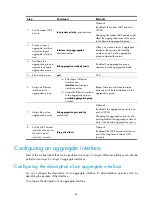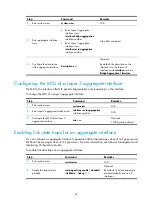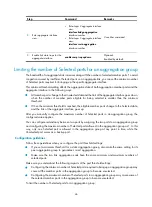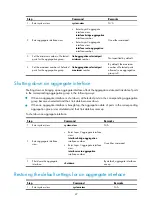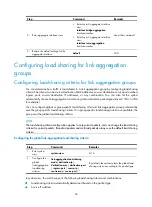
37
Table 5
A comparison between static and dynamic aggregation modes
Aggregation
mode
LACP status on
member ports Pros Cons
Static Disabled
Aggregation is stable. Peers do
not affect the aggregation state of
the member ports.
The member ports do not adjust the
aggregation state according to
that of the peer ports. The
administrator must manually
maintain link aggregations.
Dynamic Enabled
The administrator does not need to
maintain link aggregations. The
peer systems maintain the
aggregation state of the member
ports automatically.
Aggregation is unstable. The
aggregation state of the member
ports is susceptible to network
changes.
The following points apply to a dynamic link aggregation group:
•
A Selected port can receive and send LACPDUs.
•
An Unselected port can receive and send LACPDUs only if it is up and has the same class-two
configurations as the aggregate interface.
Aggregating links in static mode
LACP is disabled on the member ports in a static aggregation group. You must manually maintain the
aggregation state of the member ports.
The static link aggregation process comprises:
•
•
Setting the aggregation state of each member port
Selecting a reference port
The system selects a reference port from the member ports that are:
•
Are in the up state and have
•
Have the same class-two configurations as the aggregate interface.
The candidate ports are sorted by aggregation priority, duplex, and speed in the following order:
•
Lowest aggregation priority value
•
Full duplex/high speed
•
Full duplex/low speed
•
Half duplex/high speed
•
Half duplex/low speed
The one at the top is selected as the reference port. If two ports have the same aggregation priority,
duplex mode, and speed, the one with the lower port number wins.
Setting the aggregation state of each member port
After selecting the reference port, the static aggregation group sets the aggregation state of each
member port, as shown in
. After the static aggregation group has reached the limit on Selected
ports, any port assigned to the group is placed in Unselected state to avoid traffic interruption on the
current Selected ports.






















